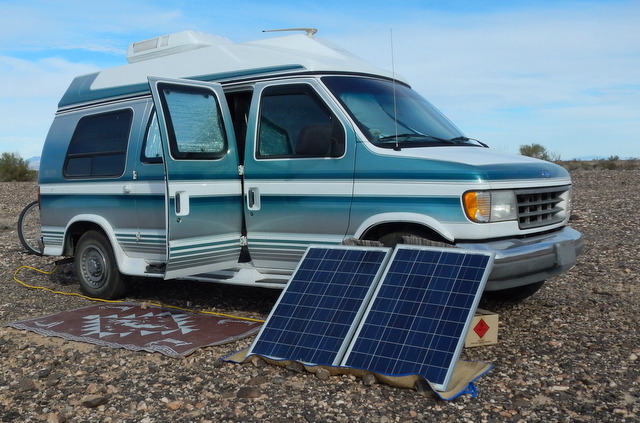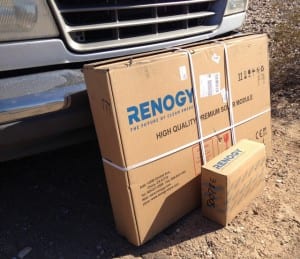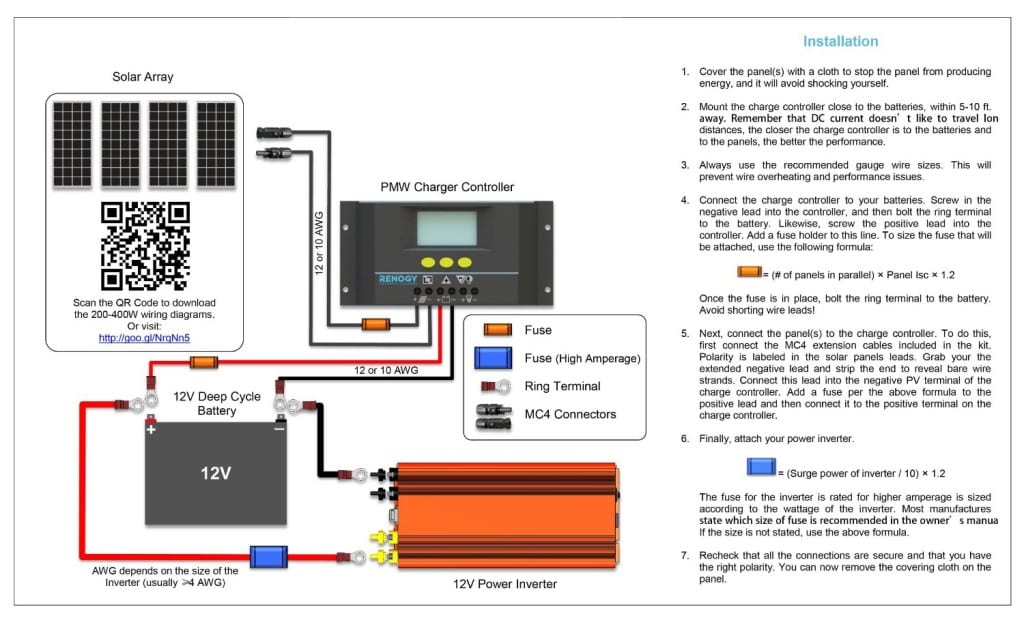By Bob Wells –
While solar power has been around for a long time now, for most of us it was so expensive we couldn’t really afford it. And if we could afford it we found it too confusing to figure out what we needed and how and where to get it. Most of us just threw our hands up in the air and decided it wasn’t for us.
However, in the last few years all that has started to change as the price of solar has dropped dramatically. Suddenly solar prices are reasonable and the average person can actually afford it for their homes, van or RV.
But that still left the problem of how to get it installed. If you paid someone else to install it the costs would skyrocket and most people didn’t know what to buy or how to install it. So it still remained out of reach for most of us.
One company set out to change all that and to an amazing degree they have succeeded. Renogy came into existence in 2011 but in just 4 years they have revolutionized solar power.
I know at least a dozen people who own Renogy solar panels or complete systems and they are all totally satisfied with them. What makes them unique is the fact that you can order a complete kit for a very low price right off Amazon.com and get free shipping on it as well. That eliminates most of the decision making and cuts the high cost of shipping out of the picture.
In fact, they are so popular and so good that my standard recommendation for most people on a tight budget is to order a 100, 200 or 400 watt kit from Amazon, depending on their budget and power needs. If you have a little more money to play with, and are willing to do your homework, I think you’re better off to spend a little more and buy higher quality individual components, but that requires a lot more learning and study, plus more money, so for most people it’s just not worth it.
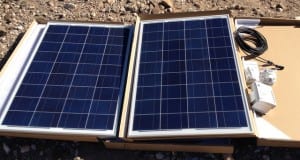
Here are the two boxes opened up: Two 100,watt panels, MPPT controller, wiring and mounting feet: Bob Wells
You can’t go wrong with a Renogy kit but you still have to make a few choices. If your budget is tight, then that will be the deciding factor and it makes the decisions for you. In fact today we are taking a look at how a friend of mine (she’s known as Dandelion on my forum) installed her Renogy system.
Before you do anything else you need to answer a few basic questions. Here are my recommendations.
How much solar do I need?
Renogy mainly sells 100 watt panels which helps keep their prices low. You decide how large your system is by how many panels you buy. Here are my recommendations on what you might need:
A 100 watt kit is probably enough if you have very minimal power needs like a LED light, your cell phone, laptop and a few other small devices; a single 100 watt panel will do that just fine. Renogy 100W Mono Starter Kit: 100W Panel, Charge Controller
But if you want to watch TV, use a 12 volt compressor fridge or run a fan a lot, you need 200 watts: two 100 watt panels. 200W Mono Starter Kit: 2pc 100W Solar Panels
If you want to use a microwave or have Satellite TV you need 400 watts: four 100 watt panels.
RENOGY® Solar Panel Starter Kit 400W Mono:
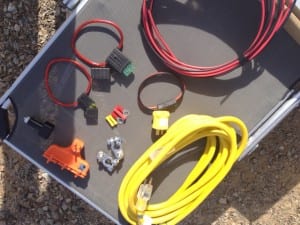
These are the parts they added because they didn’t come in the kit. Renogy doesn’t send you any fuses and you really do need to fuse everything. They also didn’t include any quick disconnects so they bought an SAE quick disconnect to mount to the controller. The rest is to be able to use the extension cord: Bob Wells
My recommendation is very simple; buy all you can afford. Why? Because you need to plan for the worst weather conditions, not the best. You will run into storms and clouds and if you don’t want to run out of power you must have more solar than you need in good weather. If you buy all you can afford, even if it seems like too much, you’ll be ready for bad weather and able to add extra electrical devices you didn’t even know you wanted.
For most people, 200 watts is the sweet spot with enough power to meet your needs for the least amount of money. Start there if you can afford it and if you can’t then get a 100 watt kit to see if that’s enough and if it isn’t you can add a second 100 watt kit when you can afford it. My friend Dandelion bought a 200 watt kit.
Where to mount the panels?
Dandelion who has a conversion van with a high top. Like most high-top vans, her fiberglass roof is very convoluted and she had a hard time finding a place to mount even one panel much less two. So she decided to do what a lot of people do and not mount them on her roof at all, instead she carries them inside her van until she gets to where she’s camping and then she takes them out and sets them on the ground. Not mounting them on the roof has lots of advantages:
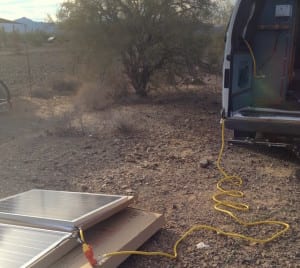
By placing the panels away from the van, you can park in the shade while they are in full sun: Bob Wells
It makes installation so much easier that most people can do it by themselves with a little guidance. Dandelion was fortunate in that she had a friend here in camp who led her through the whole process making it much easier.
You don’t have to drill holes in the roof which is a very scary idea for a lot of people and eliminates the risk of leaks.
You can park the van in the shade and move the panel out into the sunshine, keeping it much cooler in the summer.
It’s easy to tilt the panels, you just lean them up against something like the side of the van.
It’s easy to turn the panels to always be facing the sun. The combination of tilting and tracking the sun with your panels will give you a lot more power into your battery at the end of the day.
What are the disadvantages of not mounting the panels?
The main disadvantage is you can’t use them while you’re traveling and you can’t use them in the city. It’s also a hassle to have to store them away every time you need to run into town. We each have to measure the pros and cons for ourselves. For city dwellers or frequent travelers it’s a bad choice; for boondockers it’s a great choice. For boondockers another very good option is to buy the 100 watt folding suitcase solar panel from Renogy; we’ll talk about that in my next post.
Should I buy a PWM or MPPT controller?
I won’t go into details but the main difference between the two kinds of controllers is that the MPPT is more efficient and will get 25% – 35% more amps into the battery than a PWM controller will. That should make it an easy decision except it costs so much more than a PWM.
For example, Renolgy sells the same 200 watt kit with either a PWM or MPPT controller and the PWM controller is $320 Renogy 200W Poly: 200W 30A with PWM controller and the MPPT controller is $480 so it costs a lot more RENOGY® 200 watt Mono Solar kit with 20A MPPT Controller. To be fair the controller has many other nice features besides being MPPT and this kit is mono instead of poly, but they will both do the same basic job.
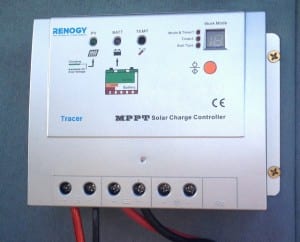
The MPPT controller that came with the kit. It’s made by Tracer and is a good quality unit: Bob Wells
Which should you get? An MPPT controller will give you about 33% more power into your battery but will cost much more, so many people argue that instead of buying the more expensive controller, you should just buy a third solar panel which will give you 33% more power. But that means you have to have enough room on your roof for a third panel, which dandelion didn’t have, or she has to carry and store a third panel and take it in and out every time she drives. She didn’t want to have to do that so she ordered the kit with the nice MPPT controller that is currently $480 at Amazon You can get it from Amazon here: RENOGY® 200 watt Solar Panel Kit Mono 20 amp MPPT Controller
The kit includes :
Two Renogy 100 Watt Monocrystalline Solar Panels
20 Amp High Quality Renogy MPPT Charge Controller
Uniquely Designed Z brackets for Mounting on Flat Surface;
UL Listed 20′ Solar MC4 Adaptor Cables: AWG 12
Because she didn’t mount the panels on the roof the Z brackets were unneeded and to make it easier to connect and disconnect the panels she adapted a standard 110 volt outdoor extension cord instead of the MC4 extension cord so she didn’t need the it either.
Fortunately, Amazon sells a 200 watt kit with a PWM controller and without the feet or extension cable for $309: Renogy Solar Panel Bundle 200 Watt. For many of you on a tight budget, this kit is your very best choice. The kit doesn’t come with fuses so you will need to buy them separately.
Dandelion’s Installation:
First thing to do when you start the installation is to decide where you are going to mount the controller. Because you don’t want to draw the voltage of your battery down below 12.2 volt (50% of capacity) you need to monitor it’s voltage every night. For that reason I recommend you put the controller somewhere in easy eyesight so you can see it’s voltage at a glance.
Also because she wasn’t mounting her panels on the roof she wanted to put it close to a window that opened so that she could just put the cord through rather than drill a hole. She had a wall near her back door that was perfect.
She wanted the extension cord to be easy to connect and disconnect and also be very strong and durable. So rather than use a common solar power extension cable she decided to use a heavy duty outdoor 110 volt extension cable like the heavy duty yellow ones you see at construction sites. She wanted to be able to park the van in the shade and set the panels far enough away so they could be in the sun and that meant a long extension cable.
To be sure it didn’t have a voltage drop out to 50 feet she bought a 10 gauge cord. You can buy a 50 foot, 10 gauge cord here at Amazon: Coleman 10/3 Vinyl Outdoor Extension Cord She used a standard SAE Quick Connector to connect it to the controller.
In a laer post I’ll give you details on how to adapt the 110 volt cord to use it with your solar panels. I’ll also talk about connecting your panels in series instead of parallel to reduce the voltage drop over a distance.
Republished with permission from CheapRVLiving.com. Bob Wells has been a full-time Van Dweller for 12 years and love’s it. He hopes to never live in a house again.


